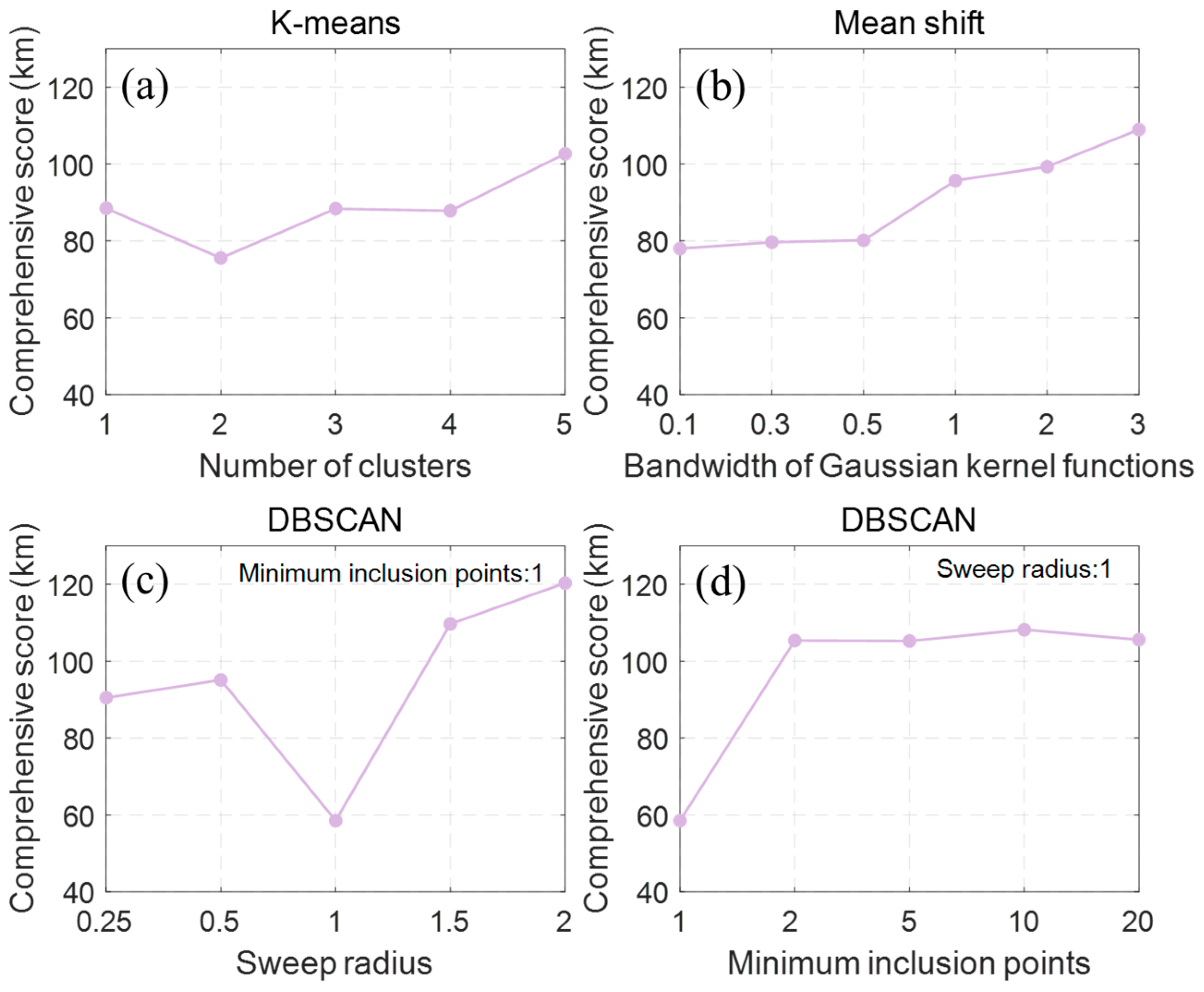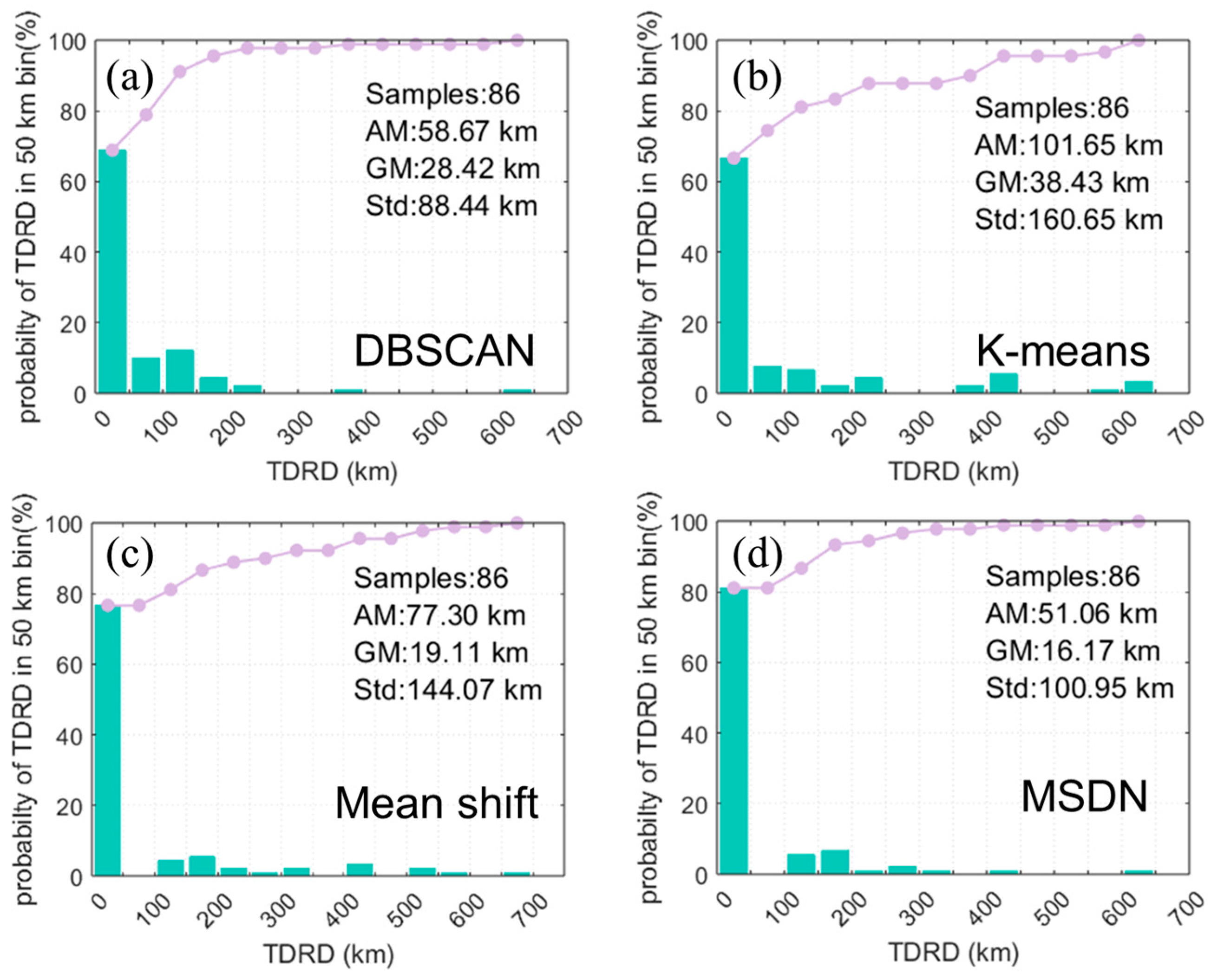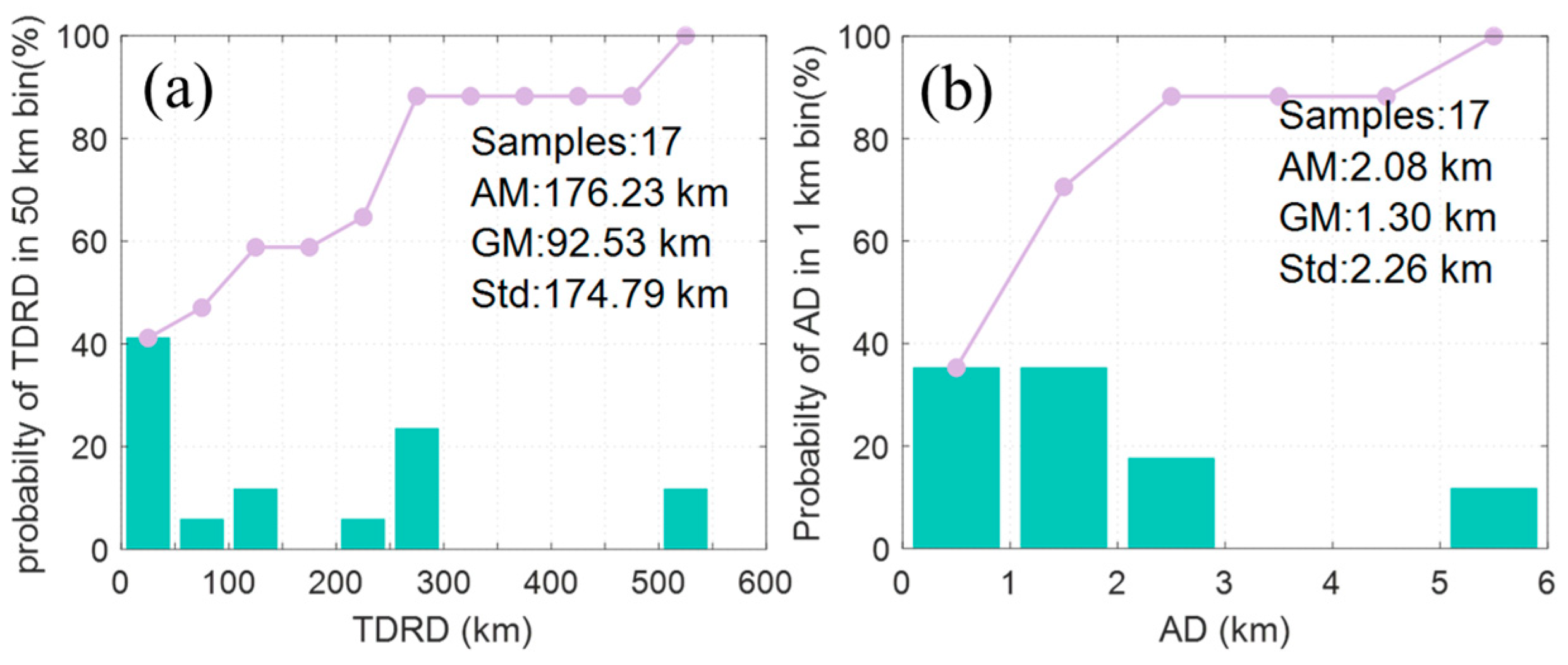Locating Strong Electromagnetic Pulses Recorded by a Single Satellite with Cluster Analysis and Worldwide Lightning Location Network Observations
Abstract
:1. Introduction
2. Detection System and Data
2.1. Wideband Electromagnetic Pulse Detector
2.2. Worldwide Lightning Location Network
2.3. Guangdong–Hong Kong–Macao Lightning Location System
3. Theories and Methodology
3.1. Basic Theory
3.2. The Methods of Locating Strong Electromagnetic Pulses
4. Results and Analysis
4.1. Relationship Between Strong Electromagnetic Pulses and Lightning Discharges
4.2. Assessing the Impact of Various Clustering Algorithms on the Cluster Analysis Locating Method
5. Conclusions
Author Contributions
Funding
Data Availability Statement
Acknowledgments
Conflicts of Interest
References
- Rakov, V.A.; Uman, M.A. Lightning: Physics and Effects; Cambridge University Press: Cambridge, UK; New York, NY, USA, 2003; ISBN 978-0-521-58327-5. [Google Scholar]
- Holden, D.N.; Munson, C.P.; Devenport, J.C. Satellite observations of transionospheric pulse pairs. Geophys. Res. Lett. 1995, 22, 889–892. [Google Scholar] [CrossRef]
- Troglia Gamba, M.; Polidori, B.D.; Minetto, A.; Dovis, F.; Banfi, E.; Dominici, F. GNSS Radio Frequency Interference Monitoring from LEO Satellites: An In-Laboratory Prototype. Sensors 2024, 24, 508. [Google Scholar] [CrossRef] [PubMed]
- Waters, C.L.; Anderson, B.J.; Liou, K. Estimation of global field aligned currents using the iridium® System magnetometer data. Geophys. Res. Lett. 2001, 28, 2165–2168. [Google Scholar] [CrossRef]
- Behnke, S.; Katko, K.; Edens, H.; Gatlin, P.; Lang, T.; Haynes, W.; Snow, P.; Rushton, J.; Renck, J.; Weaver, C.; et al. CubeSpark: Space-based 3-D Lightning Mapping using a Constellation of Radio Frequency Sensors. In Proceedings of the Copernicus Meetings, Vienna, Austria, 14–19 April 2024. [Google Scholar] [CrossRef]
- Jacobson, A.R.; Knox, S.O.; Franz, R.; Enemark, D.C. FORTE observations of lightning radio-frequency signatures: Capabilities and basic results. Radio Sci. 1999, 34, 337–354. [Google Scholar] [CrossRef]
- Dolgonosov, M.S.; Gotlib, V.M.; Vavilov, D.I.; Zelenyi, L.M.; Klimov, S.I. “Solitary” Trans-Ionospheric Pulse Pairs onboard of the microsatellite “Chibis-M”. Adv. Space Res. 2015, 56, 1177–1184. [Google Scholar] [CrossRef]
- Kikuchi, H.; Yoshida, S.; Morimoto, T.; Ushio, T.; Kawasaki, Z. VHF Radio Wave Observations by Maido-1 Satellite and Evaluation of Its Relationship with Lightning Discharges. IEICE Trans. Commun. 2013, E96-B, 880–886. [Google Scholar] [CrossRef]
- Lay, E.H.; Romero, L.; Peterson, M.; Nag, A.; Behnke, S.; Pailoor, N. Radio Frequency Sensor: Very High Frequency Radio Frequency Lightning Detection in Geostationary Orbit. Radio Sci. 2024, 59, e2023RS007931. [Google Scholar] [CrossRef]
- Li, Z.; Cao, B.; Li, P.; Li, X. Methodology and experiment study for the derivation of propagation parameters of the transionospheric electromagnetic pulses. Chin. J. Geophys. 2024. [Google Scholar]
- Jacobson, A.R.; Cummins, K.L.; Carter, M.; Klingner, P.; Roussel-Dupré, D.; Knox, S.O. FORTE radio-frequency observations of lightning strokes detected by the National Lightning Detection Network. J. Geophys. Res. 2000, 105, 15653–15662. [Google Scholar] [CrossRef]
- Tierney, H.E.; Jacobson, A.R.; Beasley, W.H.; Argo, P.E. Determination of source thunderstorms for VHF emissions observed by the FORTE satellite. Radio Sci. 2001, 36, 79–96. [Google Scholar] [CrossRef]
- Ahmed, M.; Seraj, R.; Islam, S.M.S. The k-means Algorithm: A Comprehensive Survey and Performance Evaluation. Electronics 2020, 9, 1295. [Google Scholar] [CrossRef]
- Comaniciu, D.; Meer, P. Mean shift analysis and applications. In Proceedings of the Seventh IEEE International Conference on Computer Vision, Corfu, Greece, 20–27 September 1999; Volume 2, pp. 1197–1203. [Google Scholar] [CrossRef]
- Ester, M.; Kriegel, H.-P.; Sander, J.; Xu, X. A density-based algorithm for discovering clusters in large spatial databases with noise. In Proceedings of the Second International Conference on Knowledge Discovery and Data Mining, Portland, OR, USA, 2–4 August 1996; AAAI Press: Portland, OR, USA, 1996; pp. 226–231. [Google Scholar]
- Argo, P.E.; Joseph Fitzgerald, T.; Freeman, M.J. TransIonospheric Chirp Event Classifier. In Proceedings of the Applications of Time-Frequency and Time-Scale Methods, University of Warwick, Coventry, UK, 30–31 August 1995. [Google Scholar]
- Li, Z.; Zhang, T.; Wei, Y.; Wang, Y.; Wang, L.; Duan, C.; Li, X.; Cao, B.; Li, P. Satellite Observations of Global Radio Frequency Noise and Strong Interference Events at 500 km Altitude: Basic Characteristics and Geographical Distribution. Adv. Space Res. 2024. under review. [Google Scholar]
- Enemark, D.C.; Shipley, M.E. The FORTE Receiver and Sub-Band Triggering Unit; Los Alamos National Lab.: Los Alamos, NM, USA, 1994. [Google Scholar]
- Rodger, C.J.; Brundell, J.B.; Dowden, R.L. Location accuracy of VLF World-Wide Lightning Location (WWLL) network: Post-algorithm upgrade. Ann. Geophys. 2005, 23, 277–290. [Google Scholar] [CrossRef]
- Hutchins, M.L.; Holzworth, R.H.; Brundell, C.J.; Rodger, J.B. Relative detection efficiency of the World Wide Lightning Location Network. Radio Sci. 2012, 47, RS6005. [Google Scholar] [CrossRef]
- Rodger, C.J.; Brundell, J.B.; Hutchins, M.; Holzworth, R.H. The world wide lightning location network (WWLLN): Update of status and applications. In Proceedings of the 2014 XXXIth URSI General Assembly and Scientific Symposium (URSI GASS), Beijing, China, 16–23 August 2014; IEEE: Beijing, China, 2014; pp. 1–2. [Google Scholar] [CrossRef]
- Liu, F.; Lu, G.; Neubert, T.; Lei, J.; Chanrion, O.; Østgaard, N.; Li, D.; Luque, A.; Gordillo-Vázquez, F.J.; Reglero, V.; et al. Optical emissions associated with narrow bipolar events from thunderstorm clouds penetrating into the stratosphere. Nat. Commun. 2021, 12, 6631. [Google Scholar] [CrossRef]
- Chen, L.; Lyu, W.; Zhang, Y.; Ma, Y. Detection results of Guangdong-Hongkong-Macao lightning location system for tall-object lightning. J. Appl. Meteorol. Sci. 2020, 31, 165–174. [Google Scholar]
- Huang, Z.; Roussel-Dupré, R. Total electron content (TEC) variability at Los Alamos, New Mexico: A comparative study: FORTE-derived TEC analysis. Radio Sci. 2005, 40, RS6007. [Google Scholar] [CrossRef]
- Lay, E.H.; Close, S.; Colestock, P.; Bust, G. Development and error analysis of nonlinear ionospheric removal algorithm for ionospheric electron density determination using broadband RF data. J. Geophys. Res. Space Phys. 2011, 116, A02316. [Google Scholar] [CrossRef]
- Massey, R.S.; Knox, S.O.; Franz, R.C.; Holden, D.N.; Rhodes, C.T. Measurements of transionospheric radio propagation parameters using the FORTE satellite. Radio Sci. 1998, 33, 1739–1753. [Google Scholar] [CrossRef]
- Light, T.E.L.; Jacobson, A.R. Characteristics of impulsive VHF lightning signals observed by the FORTE satellite. J. Geophys. Res. Atmos. 2002, 107, ACL 8-1–ACL 8-8. [Google Scholar] [CrossRef]
- Light, T.E.L. A Retrospective of Findings from the FORTE Satellite Mission. J. Geophys. Res. Atmos. 2020, 125, e2019JD032264. [Google Scholar] [CrossRef]







| Event Types | Event Count | WWLLN | GHMLLS | ||||||||
|---|---|---|---|---|---|---|---|---|---|---|---|
| +3 ms | ±30 s | ±150 s | ±300 s | +3 ms | |||||||
| MR 1 (%) | MMC 2 | MR (%) | MMC | MR (%) | MMC | MR (%) | MMC | MR (%) | MMC | ||
| ALL | 1061 | 9.61% | 1.02 | 90.96% | 35.19 | 98.49% | 162.97 | 99.06% | 329.42 | 2.07% | 1.00 |
| TISP | 226 | 7.08% | 1.00 | 88.50% | 29.88 | 95.58% | 125.18 | 95.58% | 269.25 | 0.00% | 0.00 |
| TIPP | 835 | 10.30% | 1.02 | 91.62% | 41.11 | 99.28% | 173.20 | 100% | 370.78 | 2.63% | 1.00 |
Disclaimer/Publisher’s Note: The statements, opinions and data contained in all publications are solely those of the individual author(s) and contributor(s) and not of MDPI and/or the editor(s). MDPI and/or the editor(s) disclaim responsibility for any injury to people or property resulting from any ideas, methods, instructions or products referred to in the content. |
© 2024 by the authors. Licensee MDPI, Basel, Switzerland. This article is an open access article distributed under the terms and conditions of the Creative Commons Attribution (CC BY) license (https://creativecommons.org/licenses/by/4.0/).
Share and Cite
Li, Z.; Cao, B.; Zhang, W.; Li, X.; Zhang, X.; Wei, Y.; Li, X.; Duan, C.; Li, P. Locating Strong Electromagnetic Pulses Recorded by a Single Satellite with Cluster Analysis and Worldwide Lightning Location Network Observations. Remote Sens. 2024, 16, 4442. https://doi.org/10.3390/rs16234442
Li Z, Cao B, Zhang W, Li X, Zhang X, Wei Y, Li X, Duan C, Li P. Locating Strong Electromagnetic Pulses Recorded by a Single Satellite with Cluster Analysis and Worldwide Lightning Location Network Observations. Remote Sensing. 2024; 16(23):4442. https://doi.org/10.3390/rs16234442
Chicago/Turabian StyleLi, Zongxiang, Baofeng Cao, Wenjuan Zhang, Xiaoqiang Li, Xiong Zhang, Yongli Wei, Xiao Li, Changjiao Duan, and Peng Li. 2024. "Locating Strong Electromagnetic Pulses Recorded by a Single Satellite with Cluster Analysis and Worldwide Lightning Location Network Observations" Remote Sensing 16, no. 23: 4442. https://doi.org/10.3390/rs16234442
APA StyleLi, Z., Cao, B., Zhang, W., Li, X., Zhang, X., Wei, Y., Li, X., Duan, C., & Li, P. (2024). Locating Strong Electromagnetic Pulses Recorded by a Single Satellite with Cluster Analysis and Worldwide Lightning Location Network Observations. Remote Sensing, 16(23), 4442. https://doi.org/10.3390/rs16234442






